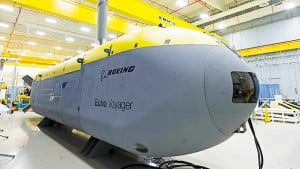The Senate Appropriations Committee’s draft fiscal year 2022 defense spending bill expressed skepticism for the speed the Navy is moving to develop a next-generation guided-missile destroyer (DDG(X)) and funding for unmanned vessel programs that is moving too quickly.
The Navy requested almost $80 million for preliminary design of the DDG(X) to help allow it to award the detail design and construction contract by fiscal year 2026. The committee’s bill report said this is almost $71 million more than requested in this account in FY ‘21.
However, the committee said “the Navy has not clearly explained the rationale for transitioning to a new class of large surface combatants [LSC] as the most modern DDG-51 Class destroyers are being constructed and enter the fleet.”
The Navy plans to procure the DDG(X) to add additional size, space, and power margin for new capabilities following production of the newest variant of the Arleigh Burke-class destroyer, the Flight III, which adds an improved air and missile defense radar system. The first of these new Flight III destroyers, the future USS Jack H. Lucas (DDG-125), is currently under production.
The committee also said it “does not have confidence in the Navy’s ability to manage the acquisition and contracting for a new class of LSC at this time.”
Therefore, the committee draft bill recommends against funding the $71 million increase.
The committee noted it does approve $42 million in funding for the integrated power and energy system test facility for prototype and land-based testing of potential future LSC power and propulsion systems. It “recommends full funding for those efforts.”
This is in line with the House Armed Services Committee FY ’22 defense authorization bill that includes a provision requiring the Navy to initiate a land-based testing site for the engineering plant of DDG(X) before starting construction on the vessel itself (Defense Daily, July 28).
Last June, the Navy stood up a new program office to develop and build the DDG(X), PMS 460. At that time, the service said that with its budget request levels it is aiming for an FY ‘22 preliminary design to lead to an FY ‘26 detail design and then start construction by FY ‘28 (Defense Daily, June 4).

Separately, the committee bill recommends against funding Phase 2 of the Large Displacement Unmanned Undersea Vehicle (LDUUV) program, which plans to transition the Phase 1 design to industry for the fabrication of at least one more LDUUV. The Navy requested $29 million for this shift.
The committee report said in the FY ‘22 budget request the Navy terminated the Payload Handling System that intended to launch the LDUUV from a Virginia-class attack submarine, “thereby limiting LDUUV deployment opportunities.” It also said the Navy delayed the Phase 2 contract award from FY ‘21 to FY ‘22 “and that the Navy is reconsidering the LDUUV program.”
Therefore, the committee recommends against funding for LDUUV Phase 2 contract award and designates unobligated fiscal year 2021 funds appropriated for LDUUV and FY ‘22 Phase I funds as “congressional special interest items for the purpose of the Base for Reprogramming.”
The committee is also concerned that the Navy is requesting funds in the Extra Large Unmanned Undersea Vehicles (XLUUVs) program for additional vessel requirements like increased payload capacity and module “when the baseline program is performing poorly.”
The Navy’s FY ‘22 request seeks $58 million to continue to build and test five XLUUVS.
In 2019, the Navy awarded Boeing [BA] a $47 million modification for the Orca XLUUV program to increase the total contract to $274 million with plans to procure five total vessels. The Orca XLUUV is based on Boeing’s Echo Voyager UUV (Defense Daily, April 1, 2019).
The bill report said that with the budget request the Navy told the congressional defense committees of schedule delays of at least two fiscal quarters plus an 18-month delay previously revealed in the FY ‘21 budget request “and that the program will need to be restructured.”
Therefore, the bill recommends not funding the increased payload capacity or universal payload in FY ‘22, which would reduce the XLUUV funding requested by about $9 million and $7 million, respectively.
The committee also directed the Comptroller General to review the Navy’s adherence to acquisition best practices with XLUUV as adapted for rapid acquisition programs. The Comptroller General is to report on this to the defense committees within 90 days of the bill’s enactment.
“The XLUUV program was awarded in response to a Joint Emergent Operational Need using rapid acquisition authorities, and given the urgency of the requirement, the Committee questions the Navy’s analytical and engineering rigor conducted prior to program initiation,” the report said.”
Relatedly, the committee also directs the Navy Secretary to provide the congressional defense committees with a report, due with the FY ’23 budget request, detailing the service’s plans for basing UUVs . This will include the infrastructure, personnel, and logistical requirements for testing, evaluation, docking, and maintenance of UUVs.